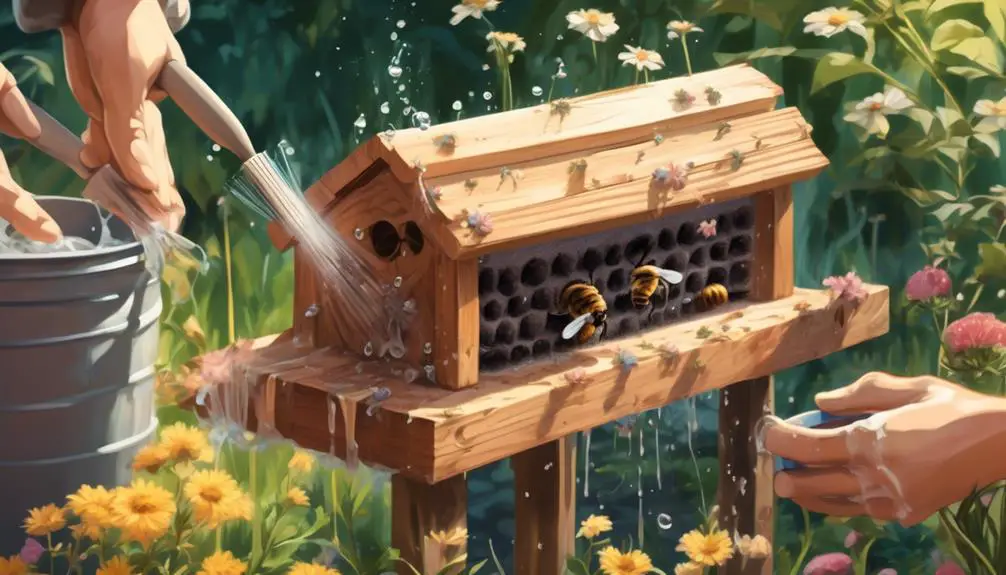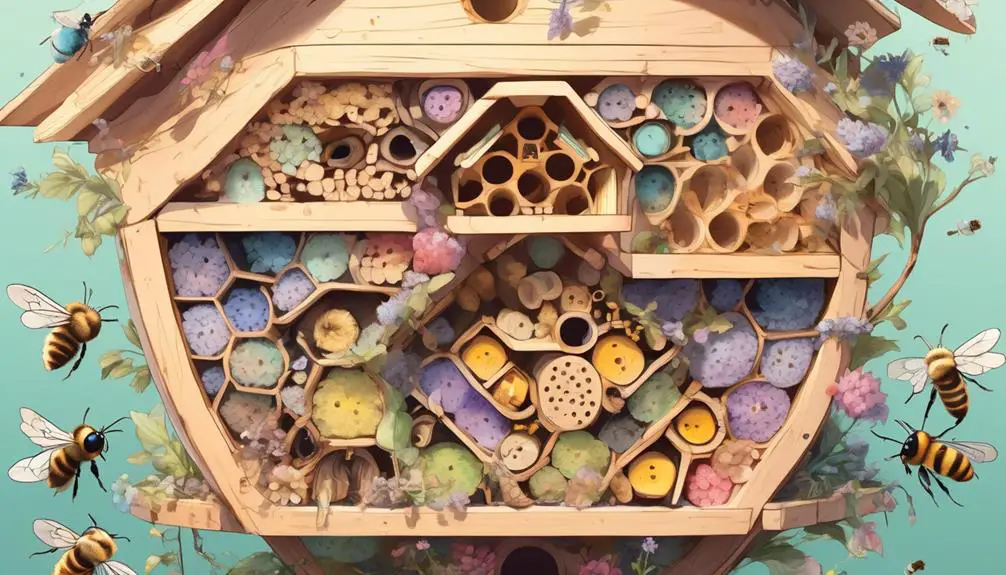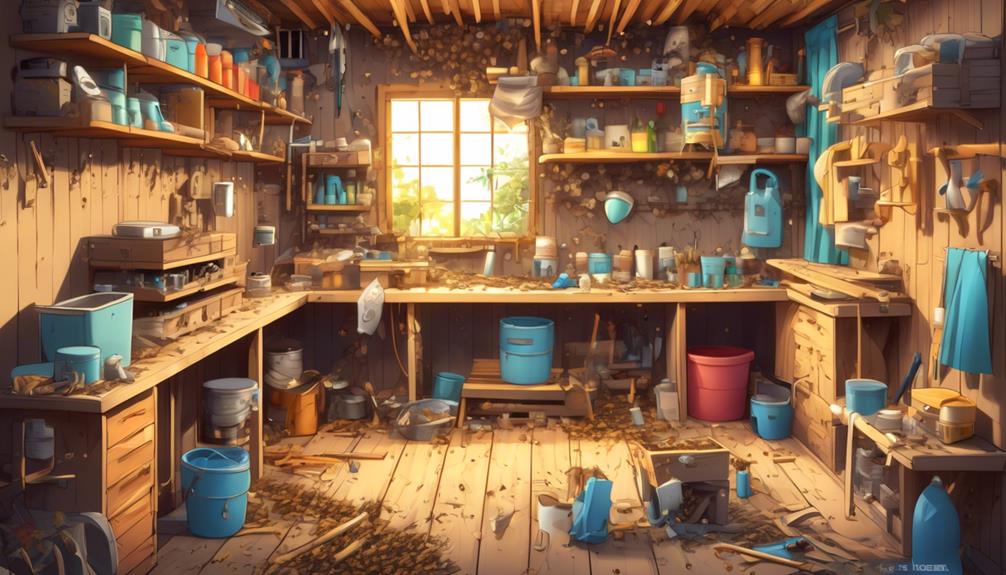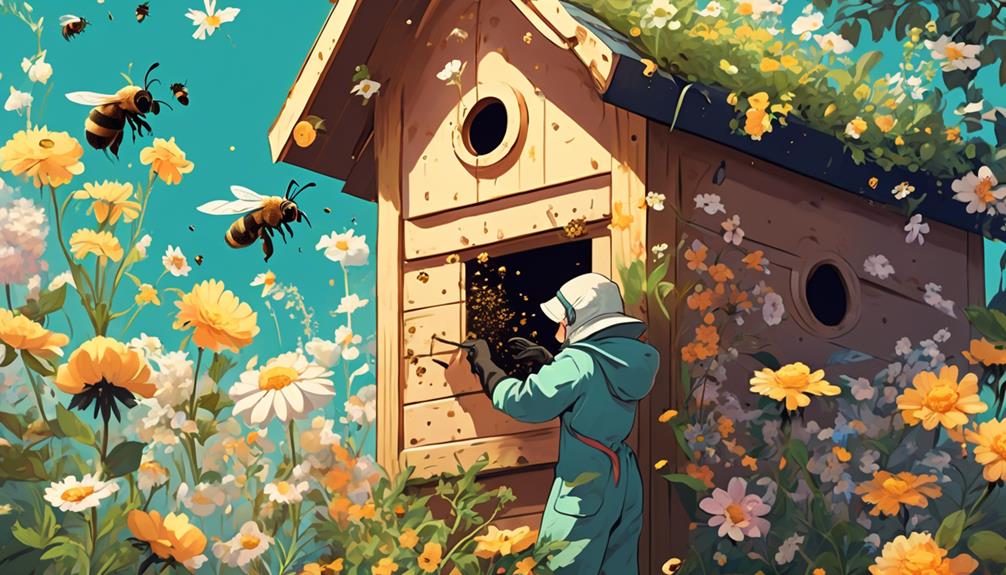Peek into the intricate process of cleaning a mason bee house, ensuring the health of your tiny pollinators and the blossoming of your garden.

How to Clean a Mason Bee House?
Just as a ship captain keeps his vessel shipshape, you too must maintain your mason bee house in tip-top condition.
Cleaning a mason bee house isn't as complex as it might seem, but it does require a keen eye and a dash of diligence. It's crucial for the health of your industrious, little pollinators and, by extension, the vibrancy of your garden.
But when is the ideal time to clean it, and what steps should you follow?
Let's explore this further together, shall we?
Key Takeaways
- Regular cleaning of a Mason Bee House is important for maintaining the health and productivity of bees.
- Cleaning should be done when bee activity has declined, usually in late fall or early winter.
- The cleaning process involves removing tubes or blocks, checking for parasites, soaking in a mild bleach solution, rinsing, and drying.
- Routine maintenance of the bee house includes regular inspections, placing it in a sunny spot, raising it off the ground, and annual cleaning and replacement of worn-out parts.
Understanding Mason Bee Houses

To fully grasp the cleaning process, you need to first understand what a Mason Bee House is and why it's an essential part of the bee's lifecycle.
A Mason Bee House, also known as a bee hotel, is a man-made structure designed to attract solitary bees. Unlike honeybees, mason bees are solitary creatures. They don't live in hives or produce honey, but they're exceptional pollinators, making them an integral part of our ecosystem.
A Mason Bee House provides a safe and secure place for these bees to lay their eggs. It's typically composed of numerous small tubes or tunnels, either made of wood, bamboo, or paper, where female mason bees deposit their eggs along with a supply of pollen and nectar for the larva to feed on. Once an egg has been laid, the bee seals off that section of the tube with a bit of mud, hence the name 'mason'.
Understanding this lifecycle is crucial because the cleaning process aims to protect these bees from parasites and diseases, therefore ensuring a healthier bee population. After all, you can't effectively clean a Mason Bee House without knowing why it's important.
Importance of Regular Cleaning

Regular cleaning of your Mason Bee House isn't just a matter of aesthetics; it's a vital step in maintaining the health and productivity of these industrious pollinators. Over time, the tubes can become congested with debris and the build-up of mites and pathogens that could harm the bee population.
Here's a table to illustrate the importance of regular cleaning:
Aspect | With Regular Cleaning | Without Regular Cleaning |
|---|---|---|
Health | Reduces disease risk. | Increased disease risk. |
Habitat | Ensures tubes are unblocked. | Tubes become congested. |
Productivity | Optimizes pollination. | Decreased pollination. |
Regular cleaning not only ensures the health of your Mason bees but also optimizes the efficiency of their pollination activity, which is crucial for your garden's health and productivity. Without regular cleaning, your Mason Bee House may become a breeding ground for disease and pests, ultimately leading to a decline in your bee population and consequently, a decrease in pollination. Therefore, it's essential that you maintain a regular cleaning schedule for your Mason Bee House to ensure the longevity and productivity of your bee population.
Ideal Time for Cleaning

Choosing the right time to clean your Mason Bee House is crucial. Ideally, clean it when the bee's activity has declined, typically in late fall or early winter. This timing avoids disturbing their lifecycle and ensures optimal health conditions for the next season. During this period, mason bees start to hibernate, and cleaning won't pose a risk to active bees or their larvae.
Cleaning at the right time also aids in the removal of harmful parasites and pathogens. These pests tend to multiply in warmer seasons and can cause significant harm to the bee population if not properly managed. It's essential to note that cleaning too early or too late can be detrimental to the bees, disrupting their lifecycle and potentially causing bee loss.
To be sure you're cleaning at the right time, observe the behavior of your bees. When activities like pollen collection and nest building cease, and the bees begin to hibernate, you know it's the right time. This observation method is particularly helpful if you live in an area where the climate doesn't strictly follow the seasonal changes.
Step-by-Step Cleaning Process

Once you've determined the optimal time for cleaning, the next crucial step is understanding the correct method to sanitize your mason bee house effectively without causing harm to the bees or their habitat.
Here's a detailed step-by-step guide:
Step | Description | Outcome |
|---|---|---|
1 | Remove tubes or blocks. | This gives you full access to the interior. |
2 | Check for parasites and dispose of affected tubes. | This prevents the spread of diseases. |
3 | Soak remaining tubes or blocks in a mild bleach solution. | This sanitizes the material. |
4 | Rinse with water and dry completely. | This prepares the house for reuse. |
5 | Reassemble the bee house. | This ensures the house is ready for new tenants. |
Start by carefully removing the tubes or blocks from the house. Examine each for signs of parasites, disposing of any affected. Soak the remaining, unaffected tubes or blocks in a mild bleach solution for about an hour to sanitize them. Rinse thoroughly with water and allow them to dry completely. Lastly, reassemble your mason bee house. By following these steps, you'll maintain a healthy habitat for your mason bees.
Maintaining Your Bee House

To ensure your mason bee house remains a thriving habitat, it's crucial you're proactive in its upkeep, implementing a routine maintenance schedule and promptly addressing any issues that may arise. Regular inspections are a key aspect of this. Look out for signs of mold, pests or disease, which can devastate your bee population if not dealt with quickly.
Consider the location of your bee house. It should be placed in a sunny, south-facing spot to encourage bees to nest. The house should also be raised off the ground to protect against predators.
Your bee house needs to be cleaned annually, ideally in late fall or early winter when the bees are in their dormant stage. This process involves removing the cocoons, cleaning the tubes or blocks, and disinfecting the house to prevent the spread of diseases.
Lastly, remember to replace worn-out or damaged parts of the bee house. Over time, the tubes or blocks may become damaged, creating an unsuitable environment for the bees. Regular replacement ensures your mason bee house remains a safe and welcoming home for these beneficial insects.
Conclusion
In conclusion, maintaining your mason bee house is paramount for a healthy bee population. Regular cleaning, ideally between late fall and early spring, keeps harmful pests and diseases at bay.
Remember, it's a simple process – disassembling the house, brushing off cocoons, washing with a mild bleach solution, and drying thoroughly.
Proper maintenance ensures your buzzing buddies continue to pollinate and thrive. So, don't neglect your bee house, it's vital to the ecosystem!



